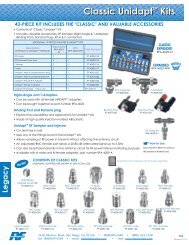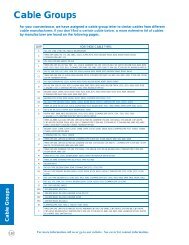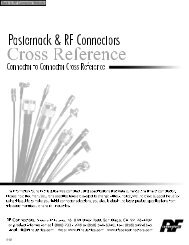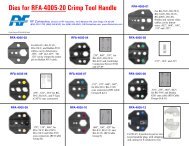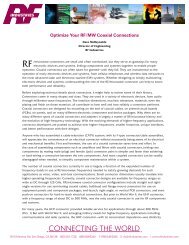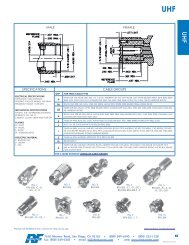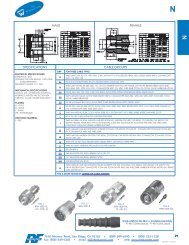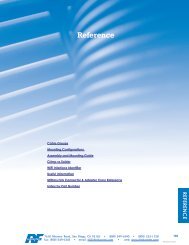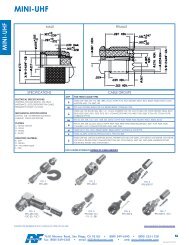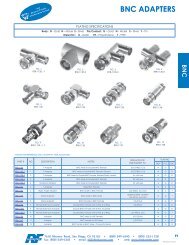RF Connectors Complete Catalog Download
RF Connectors Complete Catalog Download
RF Connectors Complete Catalog Download
You also want an ePaper? Increase the reach of your titles
YUMPU automatically turns print PDFs into web optimized ePapers that Google loves.
WiFi Interface Identifier<br />
WiFi Interface Identifier<br />
Today’s wireless market has exposed us to many new, and some familiar connectors. The wide<br />
range of antennas, access points, routers, WLAN’s, cellular devices, PCMCIA cards, Bluetooth,<br />
and wireless broadband equipment now available to meet Wi-Fi IEEE802.11a/b/g requirements<br />
can sometimes seem bewildering. What are the input and output connectors used with Wi-Fi<br />
certified products which include: access points, gateways, residential gateways, PC cards,<br />
PCI cards, PCMCIA cards, UB devices, wireless print servers, WLAN enabled computers, PC<br />
peripherals, antennas, LANs and Internet access devices? Many of these connectors are not<br />
easily recognizable. We will try to give you a little background on the common Wi-Fi connectors<br />
and some tips to help you identify them.<br />
In addition to specialized interfaces which are relatively new to the coaxial market, such as<br />
DMX, MC Card, MHF, there are variations on standard <strong>RF</strong> connectors styles which satisfy FCC<br />
Part 15 and 802.11 requirements. The most popular method used to achieve compliance has<br />
been to create reverse polarity, or gender, versions of BNC, MCX, MMCX, N, SMA, SMB, SSMB<br />
and TNC connectors. You will also find reverse, or left-handed thread versions of N, SMA and<br />
TNC connectors.<br />
QMA<br />
QMA connectors are quick disconnecting versions of SMA<br />
connectors; they snap on and off rather than mate by turning<br />
threads. QMA’s couple in two seconds rather than twenty,<br />
but more importantly, they can be rotated 360 degrees after<br />
they are mated, optimizing the flexibility of installations and<br />
durability of jumpers. The QMA coupling mechanism creates<br />
a 360-degree butt joint that is maintained even with rotation,<br />
resulting in low <strong>RF</strong> leakage. Because QMA’s are internally<br />
identical to SMA’s, they offer low loss <strong>RF</strong> performance from<br />
DC to 6 GHz, but can be used up to 18 GHz. They offer the high power handling capability of<br />
the SMA with the ability to be used in a denser environment. This is one of the reasons we are<br />
seeing increased usage of this 50-ohm interface in the Wi-Fi device arena.<br />
REFERENCE<br />
FME<br />
FME, or “Euro-Nipple”, connectors originated in Europe and<br />
are used most prominently in antenna couplings. They have<br />
50 ohm impedance and operate in the frequency range of<br />
DC to 200 MHz. They mate with M8XP .75 threads and the<br />
female has the distinctive “nipple” appearance.<br />
7610 Miramar Road, San Diego, CA 92126 • (858) 549-6340 • (800) 233-1728<br />
fax: (858) 549-6345 • email: rfi@rfindustries.com • web: www.rfindustries.com<br />
Revised 7-27-2013<br />
182



